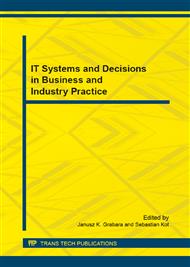p.31
p.39
p.47
p.53
p.61
p.69
p.77
p.84
p.92
Concept of Information Strategy of Virtual Organization with Using the Cloud Computing Solutions
Abstract:
Dynamic changes in the environment with constant technological developments, influence the emergence of new forms of conducting business. One of the important forms of conducting a contemporary market activity, becomes a model of virtual organization. Generally, virtual organization is a collective of independent, specialized and often geographically dispersed business units (eg. enterprises, divisional parts of companies, institutions, individuals), combining their resources and forming the cooperation for the realization of a particular purpose.The main factor enabling the cooperation of subjects, grouped within the frame of virtual organization, are a variety of resources and ICT tools (Information and Communication Technology). High efficiency and effectiveness of ICT, requires the adoption of specific information strategies of virtual organization. Currently, the Cloud Computing is an increasingly popular service model, which provides and lets for ICT use. The aim of the article is to present information strategy of VO, based on the Cloud Computing model. To achieve that ambitious objective, at the beginning of the article, the VO outline and ICT’s role in its activity, is presented. Then, referring to the M.J. Earl’s frame, a information strategy of VO was discusses, together with the indication of the role and place of Cloud Computing in VO’s information strategy. Article tops the list of national and international Cloud Computing solutions, that can support information strategy for virtual organizations.
Info:
Periodical:
Pages:
61-68
Citation:
Online since:
October 2015
Authors:
Price:
Сopyright:
© 2015 Trans Tech Publications Ltd. All Rights Reserved
Share:
Citation:


